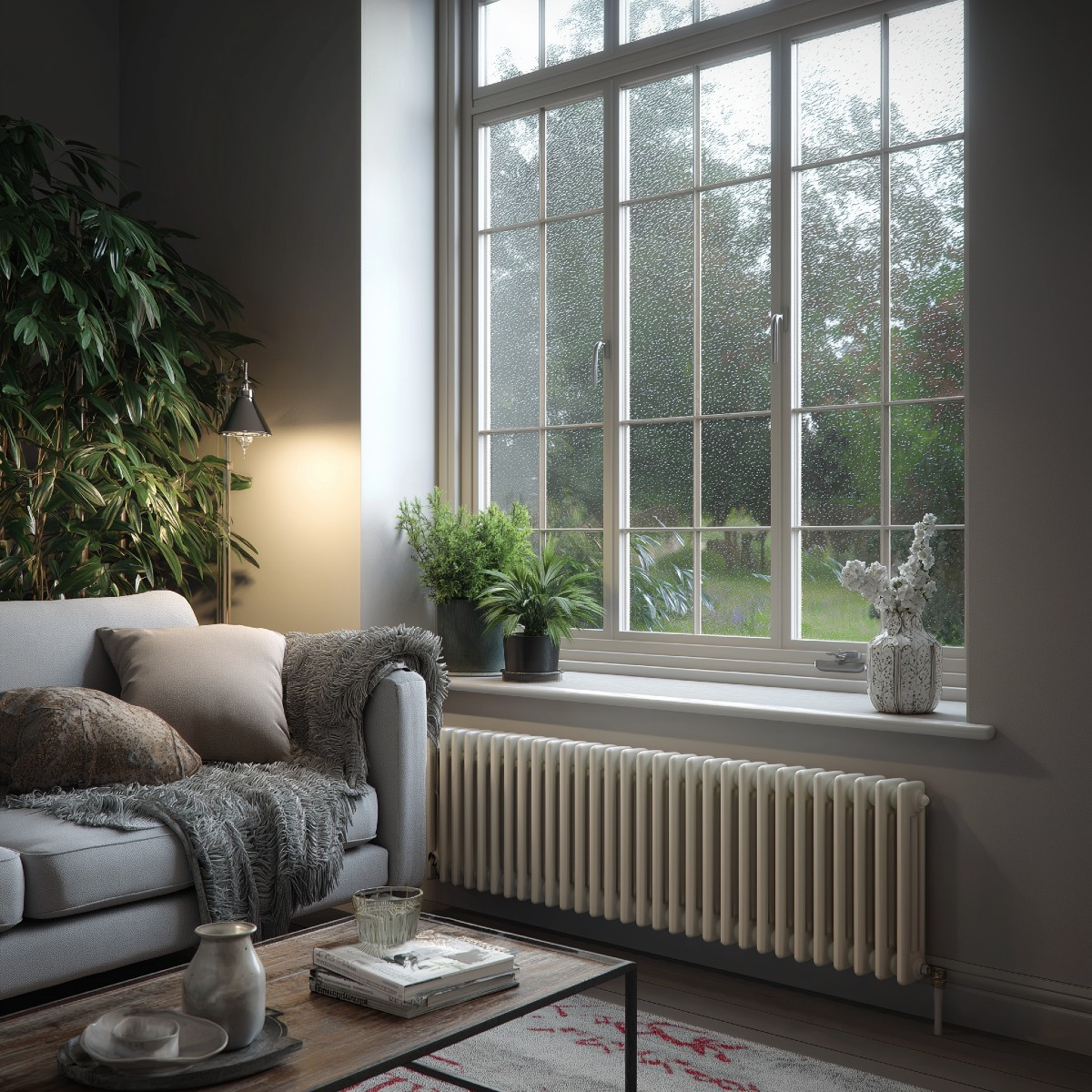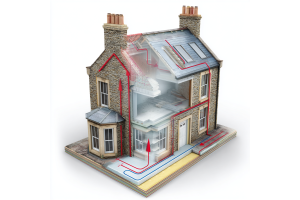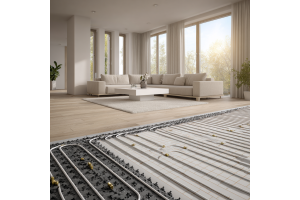
When it comes to keeping our homes warm, everyone seems to have an opinion. From family hand-me-downs (“keep the heating on low all day—it’s cheaper”) to advice passed around online (“paint your radiators black for better heat”), the internet and word of mouth are full of heating “hacks.” The trouble is, many of these so-called tips are based on myths, half-truths, or outdated practices. Following them doesn’t just risk wasting energy—it can actually make your heating system work harder, shorten the lifespan of your radiators, and push up your bills.
In the UK especially, where heating accounts for more than 60% of household energy use, making the right choices really matters. With energy prices still a concern for many households, and sustainability becoming a bigger priority, understanding how your heating system really works is essential.
At Geyser, we’ve been helping homeowners get the best from their heating for nearly two decades. We know from experience that well-designed, properly chosen radiators can transform not only the warmth of a space but also its efficiency and style. But to make the most of any heating system, you first need to clear up the confusion around common heating myths.
That’s exactly what this article will do:
-
Bust the most widespread misconceptions about home heating.
-
Explain the science behind why they’re wrong.
-
Offer practical alternatives that actually save energy, money, and stress.
By the end, you’ll have the knowledge to make smarter heating decisions—whether you’re upgrading to modern designer radiators, exploring energy-efficient options, or simply trying to cut down on unnecessary costs this winter.
Myth 1: Crank the Thermostat to Heat Up Faster
This is one of the most common misconceptions about home heating—and one of the most expensive mistakes people make. The idea seems logical: if you’re cold and want the house to warm up quickly, surely setting the thermostat to 28°C instead of your usual 21°C will make the boiler or radiator “work harder” and heat the space faster. Unfortunately, that’s not how heating systems work.
The Reality: Heating Systems Don’t Work Like an Accelerator Pedal
Unlike a car engine, your heating system doesn’t speed up when you turn the dial higher. Most central heating systems—whether gas, electric, or oil—operate at a fixed output rate. That means they release heat at the same speed, no matter how high you set the thermostat.
All cranking up the thermostat does is tell the system to keep running until the higher set temperature is reached. So instead of warming up faster, your home simply overheats, your boiler runs for longer, and your energy bills rise unnecessarily.
For example:
-
Setting the thermostat to 28°C instead of 21°C will not make your radiators heat up quicker—it will just keep the system running until it hits 28°C, which is far hotter than most households ever need.
-
Research shows that for every 1°C increase in thermostat setting, heating bills can rise by around 10%. Over the course of a long winter, that can add hundreds of pounds to your annual energy costs.
Why the Myth Persists
This myth is so widespread because of how we experience heating. When we’re cold, turning up the thermostat feels like “doing something.” And since the system eventually gets warmer, we assume it worked. But what really happened is simply a longer runtime—not faster heating.
Another reason is that older boilers and radiators took longer to respond, so people associated “higher settings” with “more power.” Modern radiators, especially high-efficiency aluminium or steel models, warm up quickly and evenly, making this trick completely unnecessary.
The Smarter Alternative
Instead of wasting energy by cranking up the thermostat, try these approaches:
-
Set a consistent, comfortable temperature. For most UK homes, between 18–21°C is recommended.
-
Use a programmable or smart thermostat. These can pre-heat your home just before you wake up or return from work, ensuring comfort without waste.
-
Zone your heating if possible. With thermostatic radiator valves (TRVs) or smart zoning, you can control temperatures room by room instead of overheating the entire house.
-
Upgrade to responsive radiators. Aluminium radiators, like those from Geyser, heat up quickly and retain warmth efficiently, meaning you don’t need to overcompensate with high thermostat settings.
Key Takeaway
Cranking the thermostat doesn’t heat your home faster—it only heats it longer and costs you more money. The real solution lies in efficient radiator choice, proper system controls, and steady, smart heating habits. By setting realistic temperatures and letting your system work as designed, you’ll stay comfortable, save energy, and avoid unnecessary boiler strain.
Myth 2: Leaving Heating On Low All Day Saves Money
This is perhaps the most debated heating myth—and one that still divides opinions. You may have heard the advice: “It’s cheaper to keep your heating on low all the time rather than turning it on and off.” At first glance, it sounds sensible. After all, surely it takes more energy to warm up a cold house than to just “maintain” a low background temperature?
The truth, however, is very different. Leaving your heating on all day, even at a low setting, almost always costs you more in the long run.
The Reality: Heat Loss Never Stops
Homes naturally lose heat through walls, windows, doors, and roofs. This is known as the heat loss rate. The higher the temperature inside compared to outside, the faster this heat loss happens.
-
If you keep your home at a constant temperature (say 18°C all day, even when you’re at work), your boiler has to keep topping up the heat every time it leaks out.
-
That means your heating system is working constantly—even when you don’t actually need the warmth.
-
Instead of saving money, you’re essentially paying to heat an empty house.
The Energy Saving Trust and boiler experts like Andy Kerr from BOXT confirm this: it’s always more efficient to only heat your home when you need it.
Why the Myth Persists
This myth has stuck around because of two common misconceptions:
-
Fear of Cold Starts
People worry that if the house gets “too cold,” it’ll take far more energy to heat it back up. But modern boilers, pumps, and radiators are designed to heat spaces quickly and efficiently, meaning a “cold start” is not as wasteful as it once might have been. -
Comfort vs. Cost
Some households prefer to keep a background warmth throughout the day for comfort. While this might feel easier, it’s not cost-effective unless you have extremely poor insulation—where reheating the house could take a very long time. In most modern UK homes, insulation standards make “on-demand heating” the more efficient choice.
The Smarter Alternative
Instead of leaving heating on all day, try these proven strategies:
-
Use a Programmable or Smart Thermostat
-
Set your heating to come on 30 minutes before you wake up or return from work, so the house is warm when you need it.
-
Modern smart thermostats (like Nest or Hive) “learn” your routine and adapt automatically, balancing comfort and savings.
-
-
Zone Your Heating
-
With thermostatic radiator valves (TRVs) or smart zoning, you can heat only the rooms you use—so the living room is warm in the evening but bedrooms don’t waste energy during the day.
-
-
Improve Insulation
-
The better your insulation, the longer your home will retain heat when the system is off. Loft insulation, double glazing, and draught-proofing all reduce the need for “background heating.”
-
-
Choose Efficient Radiators
-
Designer radiators from Geyser aren’t just stylish—they’re engineered for high output and rapid response, meaning your rooms heat up quickly when the system switches on.
-
Key Takeaway
Leaving the heating on low all day is a myth that can cost households hundreds of pounds extra per year. The most efficient method is simple:
-
Heat your home only when you need it.
-
Use smart controls and efficient radiators to warm rooms quickly and effectively.
-
Focus on insulation to minimise heat loss rather than paying to keep it constantly topped up.
By breaking this habit, you’ll save money, reduce energy waste, and make your home a lot more eco-friendly.
Myth 3: Closing Vents in Unused Rooms Saves Energy
It seems logical: if you’re not using a room, why waste money heating it? Many homeowners believe that by closing off radiator valves or vents in unused rooms, they’ll save energy and reduce heating bills. In reality, this approach can actually increase energy consumption, reduce comfort, and even damage your heating system over time.
The Reality: Heating Systems Are Designed for Balanced Airflow
Modern central heating systems—whether they use radiators, underfloor heating, or forced air—are carefully designed to work with balanced distribution of heat. When you shut off vents or radiator valves in certain rooms:
-
You disrupt the system’s balance.
-
Boilers, pumps, and circulation systems are designed to move water (or air) through the entire network. Closing off one or more paths increases pressure in the system.
-
This makes pumps work harder, which can lead to greater wear and tear or even reduced system lifespan.
-
-
You don’t actually reduce heat output—just redirect it inefficiently.
-
The boiler still produces the same amount of energy. Instead of reducing energy use, the system may cycle on and off more frequently (“short cycling”), which wastes energy.
-
-
You risk uneven temperatures and cold spots.
-
The closed-off rooms can get very cold, leading to condensation and damp problems. This is especially risky in UK homes, where unused spare rooms or north-facing rooms can quickly develop mould.
-
Why the Myth Persists
The idea comes from an intuitive, old-fashioned logic: “Why heat what you’re not using?” It’s also reinforced by small appliances like electric heaters, where switching them off does indeed save energy.
But central heating isn’t the same. The system is interconnected: closing one vent doesn’t “switch off” energy use, it just disturbs the way it circulates. In some cases, this can even increase fuel usage.
The Hidden Costs of Closing Vents or Radiators
-
Increased system strain: Pumps and boilers work harder under excess pressure.
-
Possible leaks in ductwork (forced air systems): Closed vents force higher air pressure into joints and seals, leading to leaks.
-
Damp and mould risks: Cold, unheated rooms become prone to condensation, which can cause costly repairs.
-
Comfort issues: Heat may not circulate evenly, so living areas can feel colder despite the boiler running.
The Smarter Alternative
If you want to reduce heating bills without harming system efficiency, try these approaches instead:
-
Use Thermostatic Radiator Valves (TRVs)
-
Instead of shutting radiators off completely, lower the TRV in unused rooms to a lower setting (e.g., frost protection mode).
-
This prevents over-heating while still allowing gentle circulation and avoiding damp.
-
-
Smart Heating Controls
-
Install smart thermostats or zoned heating systems. These let you reduce heating in rarely used areas without blocking circulation.
-
For example, you can heat bedrooms only in the evening while focusing daytime warmth on living areas.
-
-
Focus on Insulation, Not Restriction
-
Insulating walls, lofts, and windows reduces the amount of heat escaping, which lowers the system’s workload far more effectively than closing vents.
-
-
Choose Efficient Radiators
-
Modern aluminium or designer radiators from Geyser are highly responsive, warming rooms quickly when needed and cooling down fast when turned off. This makes zoning and on-demand heating more practical than trying to block circulation.
-
Key Takeaway
Closing vents or turning off radiators in unused rooms doesn’t save energy—it disrupts your system, increases strain, and may even cost you more. A better solution is to:
-
Use TRVs or smart zoning to lower, not eliminate, heat in unused spaces.
-
Keep air and water circulation consistent to maintain system health.
-
Prevent damp by ensuring all rooms are at least kept above freezing.
In short: let your heating system do what it was designed to do—circulate heat evenly—and focus your savings efforts on insulation and smarter controls instead.
Myth 4: Electric Heaters are More Efficient Than Central Heating
When the weather turns cold, it’s tempting to grab a plug-in electric heater for a quick blast of warmth. Many people assume these portable units are “more efficient” than firing up the entire central heating system—especially if you only need to warm a single room. At first glance, this seems logical: no boiler, no pipes, just instant heat.
But while electric heaters can have their uses, the idea that they are “more efficient” than central heating is a myth that often leads to higher energy bills and less comfort.
The Reality: Electricity Costs More Per Kilowatt-Hour
The key misunderstanding lies in the word “efficient.”
-
It’s true that electric heaters are technically 100% efficient at the point of use—every unit of electricity consumed is converted into heat.
-
However, in the UK, electricity costs around three to four times more per kilowatt-hour than gas (figures vary with energy tariffs but the ratio is consistent).
This means that, while the device itself doesn’t “waste” energy, you pay far more for the same amount of heat compared to a gas boiler running radiators.
Example:
-
Running a 2kW electric heater for 5 hours a day = 10kWh per day. At 28p per kWh (average UK tariff), that’s £2.80 per day.
-
Running a modern, efficient gas central heating system to heat the same room could cost less than half of that—£1.20 or less per day.
Over a winter season, the difference adds up to hundreds of pounds.
Why the Myth Persists
-
Instant Warmth
Electric heaters heat up quickly, which creates the impression they’re more efficient. But quick warmth doesn’t mean cheaper running costs. -
Targeted Heating
People assume heating one room with an electric heater saves money compared to heating the whole house. While this can be true for very short-term use (e.g., 30 minutes), the savings disappear if the heater runs for hours each day. -
Confusion Between Appliance Efficiency and Energy Cost
Many mistake 100% efficiency for cost-effectiveness, forgetting that fuel type pricing makes the bigger difference.
When Electric Heaters Can Make Sense
Electric heaters aren’t inherently bad—they just need to be used strategically. Situations where they might be useful include:
-
Short-term top-ups: e.g., sitting in a home office for an hour without heating the whole house.
-
Poorly insulated or rarely used spaces: where central heating isn’t practical to extend (e.g., garden rooms).
-
All-electric homes: where no gas supply is available, in which case modern electric radiators with thermostats are preferable to portable fan or oil-filled heaters.
-
Emergency heating: during boiler breakdowns.
The Smarter Alternative
For most UK households, central heating remains far more cost-effective for everyday use. To maximise efficiency:
-
Upgrade to Designer Radiators
-
High-output, modern radiators (like aluminium models from Geyser) heat spaces quickly and evenly, just like electric heaters—but with lower running costs when paired with a gas boiler.
-
-
Use Thermostatic Controls
-
TRVs and smart thermostats let you avoid “heating the whole house unnecessarily” by zoning heating to the rooms you’re actually using.
-
-
Insulate and Seal Heat Loss Points
-
A well-insulated home reduces the need for “quick fixes” like plug-in heaters.
-
-
If Electric is Your Only Option…
-
Choose modern electric radiators with smart controls rather than cheap fan heaters. These are designed to deliver consistent, controllable heat and can work well in well-insulated spaces.
-
Key Takeaway
While electric heaters feel efficient because they produce instant warmth, the higher cost of electricity makes them far less economical than central heating for regular use. For most homes, the smarter move is to rely on central heating with efficient radiators and smart controls—reserving electric heaters for occasional, short-term use.
In short: central heating + modern radiators = comfort + savings.
Myth 5: Bigger Heating Systems Heat Better
It’s a common belief that when it comes to heating, bigger is better. Many homeowners assume that installing an oversized boiler or choosing the largest radiators available will guarantee faster, stronger, and more reliable warmth. After all, why not have more heating power than you need—just in case?
But the truth is that oversizing your heating system doesn’t improve comfort or efficiency. In fact, it often has the opposite effect: higher bills, uneven temperatures, and unnecessary wear on equipment.
The Reality: Heating Systems Work Best When Sized Correctly
Heating systems—boilers, heat pumps, and radiators—are designed to match the specific heat demand of your home. That demand is based on factors like:
-
Room size and layout
-
Insulation levels (walls, windows, roof, and floors)
-
Number of occupants and usage patterns
-
Local climate conditions
When a system is too big for the space:
-
Short Cycling
-
An oversized boiler will heat the space too quickly and then shut off before completing a full heating cycle.
-
This “stop-start” process, known as short cycling, wastes energy and increases wear and tear on the boiler.
-
-
Inconsistent Comfort
-
Radiators may overheat some rooms while others remain cooler, creating uncomfortable temperature swings instead of steady warmth.
-
-
Higher Bills
-
Bigger systems use more energy than necessary. Just like driving a powerful car in stop-start traffic, efficiency drops when the system isn’t working steadily.
-
-
Reduced Lifespan
-
Constant cycling on and off places stress on key components, meaning more breakdowns and shorter equipment life.
-
Why the Myth Persists
-
“Safety Factor” Thinking
Homeowners often overestimate their heating needs to avoid ever feeling cold. Installers, too, sometimes oversize equipment as a “safe bet.” -
Outdated Practices
In older, poorly insulated houses, larger systems were sometimes used to compensate for heat loss. With today’s better insulation and window technology, this is rarely necessary. -
Confusion Between Power and Performance
People equate larger capacity with better performance—when in fact, efficiency and balance are the real keys to comfort.
The Smarter Alternative: Right-Sizing Your Heating System
The best heating system is not the biggest—it’s the one that’s correctly matched to your home’s actual needs. Here’s how to get it right:
-
Calculate Heat Output (BTUs or Watts)
-
Every room has a specific heat demand, often measured in BTUs (British Thermal Units) or watts.
-
Tools and calculators (often available from radiator suppliers, including Geyser) help determine the correct radiator size for each room.
-
-
Choose Radiators Based on Room Requirements
-
For small rooms, compact radiators may be sufficient.
-
For larger open-plan areas, tall vertical radiators or multiple units may provide better distribution.
-
Geyser’s High Heat Output radiators are engineered for exactly this balance: powerful enough for bigger rooms, efficient enough not to waste energy.
-
-
Consider Zoning and Controls
-
Instead of oversizing the whole system, use smart thermostats and TRVs to ensure each room gets the right amount of heat.
-
-
Factor in Modern Insulation
-
A well-insulated home requires far less heating power than you might expect. Investing in insulation can sometimes allow for smaller radiators or a lower-capacity boiler.
-
Real-World Example
-
Oversized Boiler Scenario: A family installs a 35kW boiler in a three-bedroom home that only requires 18kW. The system constantly cycles on and off, leading to annual bills that are £200–£300 higher than necessary, plus increased maintenance costs.
-
Right-Sized Boiler Scenario: The same home with an 18kW boiler runs smoothly, providing consistent warmth at a lower cost with fewer breakdowns.
Key Takeaway
Bigger does not mean better in home heating. Oversized systems waste energy, create uneven comfort, and shorten the life of your boiler and radiators. The smarter approach is:
-
Size your system correctly based on room dimensions and insulation.
-
Use efficient, high-output radiators where needed rather than oversizing the whole system.
-
Rely on smart controls to deliver warmth only where and when you need it.
In short: comfort comes from balance, not brute force.
Myth 6: Smart Programmable Thermostats Always Save Energy
With the rise of smart home technology, programmable thermostats like Nest, Hive, and Tado have become hugely popular. They’re marketed as the ultimate way to cut bills and reduce energy consumption—automatically adjusting your heating to fit your lifestyle.
It’s easy to believe that simply installing one will guarantee savings. After all, the device promises to “optimise” your heating and reduce wasted energy. But the reality is more nuanced: smart thermostats can help you save money—only if they’re installed, set up, and used correctly.
The Reality: Thermostats Don’t Save Energy by Themselves
A thermostat, smart or otherwise, doesn’t directly make your heating system more efficient. It simply controls when and how long the heating runs.
If you don’t use it properly, a smart thermostat could even end up costing you more. For example:
-
Setting overly ambitious “comfort temperatures” (like 23–24°C instead of 20–21°C).
-
Constantly overriding schedules.
-
Heating rooms you’re not using because the system hasn’t been zoned correctly.
In fact, studies have shown that some households see little to no reduction in bills after installing a smart thermostat—because behaviour and system setup are the real keys to savings.
Why the Myth Persists
-
Strong Marketing Claims
Smart thermostat manufacturers often advertise “up to 20% savings,” but those figures assume ideal usage. In reality, savings vary widely. -
Confusion Between Technology and Behaviour
Homeowners often assume the thermostat does all the work. In truth, it requires proper programming and sometimes additional upgrades (like radiator valves) to deliver maximum benefit. -
Early Success Stories
For households switching from completely manual controls, smart thermostats can feel revolutionary. But for homes already using timers or TRVs effectively, the marginal gains are smaller.
The Smarter Alternative: How to Use Smart Thermostats Effectively
A smart thermostat is a tool—and like any tool, it’s only as effective as how you use it. To maximise savings:
-
Set Realistic Comfort Temperatures
-
Stick to 18–21°C in living areas. Every extra degree can increase heating bills by around 10% per year.
-
-
Use Scheduling Wisely
-
Program heating to come on 30 minutes before you wake up or return home, and lower it while you sleep or are away.
-
Avoid “micromanaging” the system by constantly adjusting it—this often reduces efficiency.
-
-
Pair with Zoning Controls
-
Combine smart thermostats with TRVs (thermostatic radiator valves) or smart radiator valves. This allows you to heat only the rooms you actually use, rather than wasting energy on unused spaces.
-
-
Take Advantage of Advanced Features
-
Use geofencing (which adjusts heating based on your location).
-
Enable weather compensation (adjusting output depending on outside temperatures).
-
Analyse usage reports to spot wasteful patterns.
-
-
Match with the Right Radiators
-
Even the smartest thermostat can’t compensate for outdated or inefficient radiators. Geyser’s modern aluminium and designer radiators heat quickly and evenly, responding better to thermostat adjustments than older, sluggish cast-iron units.
-
Real-World Example
-
Household A installs a smart thermostat but leaves the system at 22°C all day. Result: bills remain high, and no savings are made.
-
Household B installs a smart thermostat, sets a schedule (20°C from 7–9am and 5–10pm, 16°C at night/while out), and uses TRVs to only heat bedrooms in the evening. Result: savings of £150–£200 per year compared to before.
Key Takeaway
Smart programmable thermostats are powerful tools, but they don’t automatically save energy. Correct usage, realistic temperature settings, and integration with efficient radiators and controls are essential to unlock their full potential.
Think of it this way: the thermostat is the brain, but your radiators are the heart of the system. Together, they deliver comfort and savings—but only if both are working in harmony.
Bonus Myth: Radiator Colour Affects Efficiency
You’ve probably heard the tip: “Paint your radiators black, and they’ll give out more heat.” It’s a piece of advice that gets passed around a lot, usually based on the idea that darker colours absorb and emit heat better. At first, this sounds scientific—after all, we know that black clothing feels hotter in the sun. But when it comes to radiators in your home, this is largely a myth.
The Reality: Radiator Colour Has Minimal Impact on Heat Output
Radiators release heat in two ways:
-
Convection – warm air rising as cooler air is drawn in.
-
Radiation – infrared heat emitted from the radiator surface.
-
Around 70–80% of a radiator’s heat is convection-based, meaning the colour of the radiator has no effect at all.
-
Only 20–30% is radiant heat, which can be influenced very slightly by colour.
Scientific testing has shown that while a matt black radiator may radiate marginally more heat than a glossy white one, the difference is tiny—usually less than 1% of total output. That’s nowhere near enough to make a noticeable difference in your comfort or your heating bills.
In fact, what matters most for efficiency is not colour, but:
-
Radiator design (surface area, fins, panels).
-
Material (aluminium, steel, cast iron).
-
Placement (under windows, away from obstructions).
Why the Myth Persists
-
Confusion with Solar Absorption
People associate darker colours with absorbing more heat from the sun, so they assume radiators work the same way. But radiators don’t absorb sunlight—they generate heat internally. -
Historical Context
In the early 20th century, some engineers did recommend painting cast-iron radiators dark to improve radiation. But older radiators relied more heavily on radiant heat, unlike today’s highly convective models. -
Common Sense Misinterpretation
Since we feel heat from dark surfaces more strongly in other contexts, the myth feels intuitive—even if the science doesn’t back it up.
The Smarter Alternative
Instead of worrying about radiator colour, focus on factors that genuinely improve efficiency:
-
Upgrade to Modern Radiators
-
Aluminium radiators, like those from Geyser, heat up rapidly, spread warmth evenly, and cool down quickly—ideal for energy efficiency.
-
-
Maximise Placement and Airflow
-
Keep radiators clear of large furniture and heavy curtains.
-
Use reflective radiator panels behind units on external walls to reduce heat loss.
-
-
Choose Radiators for Style, Not Just Function
-
With designer options, you don’t need to compromise. At Geyser, you can select radiators in a variety of finishes—white, anthracite, chrome, or bold colours—without worrying about efficiency losses.
-
-
Use Smart Controls
-
Pair radiators with TRVs or smart thermostats to ensure each room is heated only as needed, which saves far more energy than paint colour ever could.
-
Real-World Example
-
Household A paints their white radiators black, hoping for lower bills. The difference in efficiency is so small it’s practically unmeasurable.
-
Household B installs aluminium radiators with TRVs and reflective panels. They see real savings of £100–£200 per year because the system uses less energy to maintain comfort.
Key Takeaway
The colour of your radiator has almost no effect on how efficiently it heats your home. What truly matters is the design, material, size, and placement of the radiator, along with the efficiency of your overall heating system.
So, when choosing radiators, pick the style and finish you love—whether that’s minimalist white, sleek anthracite, or bold colours—without worrying about performance. At Geyser, every radiator is engineered to deliver the right balance of form and function.
In short: your radiator’s colour affects your décor, not your heating bills.
Closing Thoughts: Heating Smarter, Living Better
Home heating is one of those everyday essentials that most of us take for granted—until the bills arrive or the house doesn’t feel as cosy as it should. That’s why myths around heating are so persistent: they offer quick fixes, “common-sense” solutions, or tricks passed down through generations. But as we’ve seen, many of these beliefs—from cranking up the thermostat to leaving the heating on low all day or painting radiators black—don’t actually help, and some can even cost you more in the long run.
The truth is that heating efficiently is about systems, not shortcuts.
-
The type of radiators you install.
-
How well your home retains heat (insulation, windows, draft-proofing).
-
The way you use controls like thermostats and TRVs.
-
Your everyday habits around comfort and energy use.
When all of these work together, you get the best results: a home that feels warm, welcoming, and economical to run.
From Myths to Meaningful Actions
Instead of relying on outdated advice, here’s what really makes a difference:
-
Choose the right radiators for your space: Aluminium for quick response, vertical radiators for narrow spaces, or statement designer radiators that double as décor.
-
Use smart controls effectively: Program schedules, set realistic comfort temperatures, and make use of TRVs to heat only the rooms you need.
-
Think long term: Investing in modern, efficient radiators and proper heating controls will save more money over the years than any supposed “hack” ever could.
Why This Matters Now
With rising energy costs and increasing awareness of carbon footprints, the way we heat our homes has never been more important. By separating fact from fiction, you not only protect your wallet but also contribute to a more sustainable future. Heating myths may be harmless in conversation, but in practice, they can lock you into inefficient habits that waste energy and money.
The Geyser Advantage
At Geyser, we understand that heating isn’t just about warmth—it’s about comfort, design, and efficiency working hand in hand. That’s why our radiators are engineered to deliver:
-
Fast heat-up times for quick comfort.
-
Energy efficiency through smart materials like aluminium.
-
A wide range of styles and finishes so you never have to compromise between performance and aesthetics.
Whether you’re upgrading a single room or planning a whole-home heating revamp, our collection is designed to help you heat smarter—not harder.
Final Word
Don’t let myths guide how you heat your home. Instead, focus on evidence-based choices, modern technology, and efficient radiator design. By doing so, you’ll not only keep your living spaces warm and inviting but also enjoy lower bills, reduced energy waste, and a more stylish home.
In the end, the smartest way to beat heating myths is simple:
Choose quality, use your system wisely, and let your radiators do what they’re designed to do—keep you comfortably warm.
Quick Myth-Buster Summary: What You Really Need to Know
To wrap up, here’s a clear overview of the most common home heating myths, what’s wrong with them, and the smarter alternatives you should adopt. Think of this as your myth-busting cheat sheet:
| Myth | Reality | Smart Alternative |
|---|---|---|
| Cranking the thermostat heats faster | Heating systems operate at a fixed rate. Turning the dial higher only makes your boiler run longer, not faster. | Set a comfortable temperature (18–21°C) and rely on smart scheduling to warm rooms when needed. |
| Leaving heating on low all day saves money | Constantly running the system wastes energy—your home loses heat even when unoccupied. | Use programmable or smart thermostats to heat your home only when necessary. |
| Closing vents or radiators in unused rooms saves energy | Disrupts airflow, increases system strain, and can lead to damp or uneven heating. | Keep valves slightly open or use TRVs/smart zoning to control unused spaces without blocking circulation. |
| Electric heaters are more efficient than central heating | Electricity is expensive; central heating (especially gas) is more cost-effective for regular use. | Rely on efficient central heating and high-output radiators; reserve electric heaters for short-term use or poorly insulated rooms. |
| Bigger heating systems heat better | Oversized boilers or radiators short-cycle, reduce comfort, and waste energy. | Right-size your system based on room dimensions, insulation, and heat requirements. |
| Smart thermostats always save energy | Savings only occur if the system is programmed correctly and used wisely. Misuse can increase bills. | Set realistic schedules, pair with TRVs, and use smart features (geofencing, weather compensation) to maximise efficiency. |
| Radiator colour affects efficiency | The vast majority of heat comes from convection, not radiation. Paint colour has negligible impact (<1% difference). | Choose radiator colour for style and décor, while focusing on design, material, and placement for real efficiency. |
Bonus Tips for Real Savings and Comfort
-
Invest in high-quality radiators – aluminium or modern designer models heat up quickly, respond efficiently to thermostats, and look great.
-
Combine smart controls with zoning – heat only the rooms you use, when you use them.
-
Check insulation and draughts – a well-sealed home requires less energy to maintain warmth.
-
Avoid shortcuts based on myths – they may feel intuitive but rarely deliver measurable savings.
Key Takeaway
Heating your home effectively isn’t about hacks or old wives’ tales. It’s about smart system design, proper controls, efficient radiators, and informed habits. By debunking these myths and applying the right strategies, you’ll enjoy:
-
Consistent, comfortable warmth
-
Lower energy bills
-
Reduced environmental impact
-
Radiators that look as good as they perform
Conclusion: Heat Smarter, Not Harder
Heating your home efficiently isn’t about following rules of thumb or old myths—it’s about understanding how your system works, choosing the right equipment, and using it wisely. As we’ve seen, many widely held beliefs—like cranking the thermostat, leaving heating on low all day, closing vents, or relying solely on electric heaters—are either ineffective or counterproductive. Believing them can lead to higher bills, uneven temperatures, and even unnecessary wear on your heating system.
The real key to comfortable, cost-effective heating lies in a holistic approach:
-
Right-sizing your system
-
Oversized boilers and radiators don’t heat better—they short-cycle, waste energy, and reduce comfort. Matching your system to your home’s actual heat demand is critical.
-
-
Investing in efficient, responsive radiators
-
Modern aluminium and designer radiators heat up quickly, distribute warmth evenly, and pair seamlessly with smart controls, allowing you to maximise comfort without overspending.
-
-
Smart and thoughtful use of controls
-
Programmable or smart thermostats, combined with TRVs and zoning, allow you to heat the spaces you use, when you need them, while avoiding energy waste in empty rooms.
-
-
Focusing on insulation and heat retention
-
Good insulation, draught-proofing, and proper radiator placement reduce the workload on your system, keeping your home warmer for longer with less energy.
-
-
Separating fact from fiction
-
Myths like radiator colour affecting efficiency or leaving the heating on low saving money are appealing shortcuts—but they don’t deliver measurable results. Evidence-based decisions are always more effective.
-
The Bottom Line
Heating your home effectively is about intelligence, not intuition. By combining the right radiators, the right system size, smart controls, and good insulation, you can enjoy:
-
Lower energy bills
-
Faster, more consistent warmth
-
A more sustainable and eco-friendly home
-
Radiators that complement your home’s style
At Geyser, we’re committed to helping homeowners achieve smart, stylish, and efficient heating solutions. Our range of radiators is designed to give you maximum performance without compromise, making it easier than ever to heat your home the right way—without falling for myths or wasting energy.
Final Thought
Don’t let common myths dictate how you heat your home. Invest in knowledge, invest in quality radiators, and use your system smartly. That’s the formula for a warmer, more comfortable home and a smarter approach to energy use.







